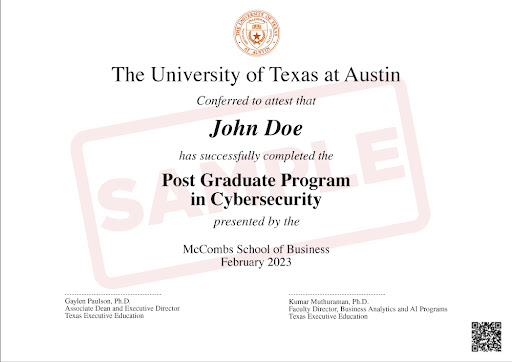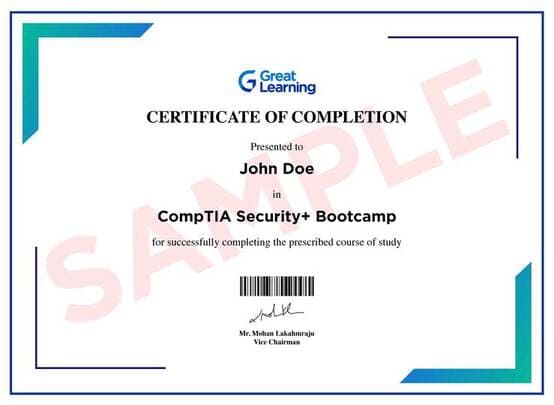Pre-work (Optional)
Graduates and professionals with limited experience in IT and Technology or those not working in these domains can take this course to learn the fundamentals required for the program. With a strong foundation, your learning journey will get streamlined.
Module 1: Introduction to Cybersecurity -2 weeks
Acquire essential knowledge in Risk Management, Cryptography, and emerging trends in cybersecurity.
- Careers in Cybersecurity
- Introduction to CIA triad
- Basics of Authentication
- Risk Management
- Emerging trends - Artificial Intelligence & Cybersecurity, Operations Technology & Internet Of Things,
- Global Cyber warfare
- Understanding Cryptography
- Cryptocurrency & blockchain
- Gain insights on Importance of Cybersecurity
- Develop the ability to choose the appropriate authentication methods
- Identify & assess different types of Risks
- Gain hands-on experience or practical exercises using AI-driven tools for cybersecurity use cases
- Discover the different patterns in the Cyber Attacks going on as a part of Global Cyber Warfare
- Familiarize yourself with the cryptocurrency transactions & the crypto payment ecosystem in today's cyber world.
Module 2: Network Security & Firewall essentials - 3 Weeks
Skill yourself with Network security concepts and experience network security tools such as firewall for safeguarding your assets.
- Networking basics - OSI Model, IP addressing, TCP/IP, Network services, Public/ Private IP, load balancing, Proxy
- Wireshark
- Network segmentation
- Virtual Private Network (VPN)
- Next Generation Firewall (NGFW)
- Intrusion Detection Systems (IDS) and Intrusion Prevention Systems (IPS)
- Develop the most in demand skills in a majority of IT job roles such as Networking & Network security
- Practice the skill of capturing and analyzing network traffic for cyber investigations & troubleshooting
- Understand the implementation of VPN for securing the remote workforce
- Explore the Next Generation Firewall (NGFW) for network security
- Distinguish between security technologies like IDS & IPS and their usage
Module 3 : Understanding Modern Cyber Attacks - 2 Weeks
Discover the cyber attack methodology and learn to view attacks from the lens of an attacker.
- MITRE ATT&CK
- Cyber Kill Chain
- APT (Advanced Persistent Threats)
- Ransomware Attacks & Cyber Insurance
- Attacks on Cryptography
- Attacks on Users
- Attacks on Networks
- Attacks on Endpoint
- Attacks on Applications
- Attacks on Data
- Attacks on Cloud
- Understand adversary Tactics,Techniques and Procedures to enhance threat detection and response strategies.
- Identify and disrupt cyber threats by understanding the different stages of a cyber attack
- Recognize and defend against highly skilled and motivated attackers with persistent access
- Mitigate financial risks from ransomware incidents through effective cyber insurance strategies
- Secure cryptographic systems by identifying and mitigating vulnerabilities and weaknesses
- Develop comprehensive security strategies to protect critical components against various attack vectors.
Module 4: Designing Security Controls - 3 Weeks
Discover effective methods for recognizing and applying appropriate cybersecurity strategies to combat diverse cyber threats.
- Types of security controls
- Endpoint security controls- Antivirus, Endpoint Detection and Response (EDR), Extended Detection and Response (XDR)
- Identity and Access Management (IDAM)
- Security Awareness
- Data Security Controls - Data Loss Prevention (DLP), Cloud Access Security Broker (CASB), Data Encryption, Masking
- Authentication Implementation
- Deep dive into Security Information and Event Management (SIEM)
- Threat Intelligence
- Incident Response
- Incident Response Playbooks
- Differentiate between the types of security controls & their implementation
- Delve deeper into the protection mechanisms for endpoints such as Laptops, Desktops & Servers
- Identify & classify different types of Data. Configure policies for preventing data leakage from enterprise networks
- Monitor the signs of ongoing cyber attacks within a network with alerts from authentication servers
- Learn about continuous security monitoring with advanced threat detection
- Learn to proactively gather actionable intelligence & stay informed about the threat landscape
- Plan to respond to incidents and understand the incident response lifecycle
Module 5: Governance, Risk and Compliance -2 weeks
Gain understanding of various standards, regulations and frameworks to help build a strong organizational security posture.
- ISO 27001:2022
- Regulations, standards, and legislation
- General Data Protection Regulation (GDPR)
- Digital Data Protection Act (DPDP)
- Payment Card Industry Data Security Standard (PCI DSS)
- Digital Operational Resilience Act (DORA)
- Understanding Audit Process
- Conducting an internal audit
- Certification Audits
- Third-party risk management
- Comprehend the compliance requirements in relation to the security standards such as ISO 27001
- Have technical expertise in documenting the requirements for dat protection standards & laws such as GDPR, and DPDP
- Recognize the need for security specific to Financial sector by studying the intricacies of DORA
- Practice the preparation of internal audits and how to conduct them yourself confidently
- Recognize and treat the risks associated with supply chain management
Module 6: Cloud Security -2 weeks
Delve deeper into cloud security controls and understand the methodology behind securing data on cloud.
- Cloud Security in different platforms
- Cloud platform and Infrastructure Security
- Securing Data on Cloud
- Incident Detection and Response in Cloud
- Implement robust security measures tailored to Microsoft Azure for enhanced protection
- Safeguard cloud infrastructure against cyber threats and vulnerabilities through effective security controls.
- Ensure the confidentiality, integrity, and availability of data stored on cloud platforms through encryption, access controls, and data loss prevention measures.
- Detect and respond to security incidents in cloud environments promptly to minimize impact and protect sensitive assets
Module 7: Penetration Testing -4 weeks
Equip yourself with a solid grasp of penetration testing methodologies and gain hands-on experience through interactive video and workbooks, ensuring industry readiness.
- Introduction to Penetration Testing
- Techniques of Penetration Testing
- Infrastructure Penetration Testing
- OWASP Top 10 & Application Security
- Web Application Penetration Testing
- Practice the fundamental skills of penetration testing
- Differentiate between different methods used while performing the penetration tests
- Scanning the internal infrastructure and exploiting vulnerabilities to secure the network
- Have an understanding of application security vulnerabilities such as OWASP Top 10
- Understand how pentesting of a web application differs from Infrastructure penetration testing
Optional: Masterclass Series – Cybersecurity & Artificial Intelligence: Empowering Next-Gen Security Professionals
The live industry expert-led masterclasses will help learners to augment cybersecurity skills with AI technologies.
- Masterclass 1: Essentials of Artificial Intelligence and its role in cybersecurity
- Masterclass 2: Leveraging AI for Network Security
- Masterclass 3: Survey of exploitation and manipulation techniques in Generative AI
- Masterclass 4: Strengthening security systems with AI
- Masterclass 5: Measuring risks associated with AI
- Familiarize yourself with Machine Learning and Artificial Intelligence technologies
- Understand the innovations in machine learning and automation that are shaping the security landscape
- Familiarize yourself with AI technologies that help with network incident detection
- Learn about attacks on AI that involve the manipulation of machine learning models and systems
- Select the right AI integration for security that enhances threat detection and response
- Identify the risks associated with the use of Generative AI
Optional: Capstone Project -2 weeks
Test your knowledge from the cybersecurity program.
- Setting up Security Operations & Monitoring using SIEM
- Planning Security Operations & Monitoring using Risk Control mapping
- Research and prepare your assessment whether ChatGPT or gemini should be allowed by an organization
Additional Self Paced Module: Python for Cybersecurity Professionals
Learn to use Python for cybersecurity
- Introduction to Python
- Network analysis with Python
- Cracking passwords with Python
- Encryption with Python
- Learn to use python to perform and automate tasks.
- Understand the usage of python programming for network analysis, password cracking and encryption.






















.jpg)
.jpg)

.jpg)
.jpg)

.jpg)
.jpg)








